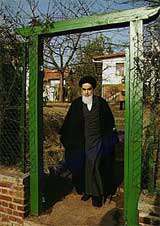(September 24, 1902 – June 3, 1989)
Ayatollah Khomeini founded the first modern Islamic republic was an Iranian Shi'a cleric and the political and spiritual leader of the 1979 revolution that overthrew Mohammad Reza Pahlavi, the then Shah of Iran. He was considered a spiritual leader to many Shia Muslims and ruled Iran from the Shah's overthrow to his own death in 1989. Khomeini is considered by many as one of the most influential men of the 20th century, and was named
Time Magazine's Man of the Year in 1979.
Life in exileReturn to Iran
Hostage crisisIran-Iraq war
Death and funeral
Life in exileHe was born in the town ofKhomein as Ruhollah Mousavi in 1900. As a descendent of the prophet Mohammad, he was entitled to use the style
Sayyid before his name. Khomeini was named an ayatollah in the 1950s. In 1964 he was exiled from Iran for his constant criticisms of the government of Shah Mohammad Reza Pahlavi. He was sent initially to Turkey, before later being allowed to move to Iraq, where he stayed until being forced to leave in 1978, after which he went toNeauphle-le-Château in France. According to Alexandre de Marenches (then head of the French secret services), France suggested to the Shah that they could "arrange for Khomeini to have a lethal accident"; the Shah declined the assassination offer, arguing that this would make him a martyr. Khomeini became one of the most influential opponents to the rule of the Shah, being seen as the spiritual leader of those fighting his rule. During his exile, Khomeini wrote a book titled"Guardianship of the Islamic Jurists", which laid out his beliefs which as all laws in an Islamic society should be based on the laws of Islam, all laws and activities should be monitored by authorities on Islam law (guardians), there should be no king (that Islamic countries be a republic and not a monarchy), and in place of a king there should be an Islamic/Supreme leader elected by Islamic judges. The book provides an insight on the eventual political background of the Islamic Republic of Iran.

Return to IranOnly two weeks after the Shah left Iran on January 16, Khomeini returned to Iran on Thursday February 1, 1979, invited by the anti-Shah revolution already in progress, and seized power on February 11. An Islamic republic was formed, under which a president is elected every four years, but only those candidates approved indirectly by the Supreme Leader (through a Council of Guardians) may run for the office. Khomeini himself became Head of State for life, as "Leader of the Revolution" and later "Supreme Spiritual Leader." On February 4, 1980 Khomeini approved the elected Abolhassan Banisadr as the first president of Iran.
Hostage crisisEarly in the revolution in the years of 1979 to 1981, Khomeini's followers abducted 52 United States citizens and held them hostage in Tehran's US embassy for 444 days – an event often referred to as the Iranian hostage crisis. Khomeini stated on February 23, 1980 that Iran's parliament would decide the fate of the American embassy hostages demanding the United States hand over the Shah for trial in Iran.President Jimmy Carter launched a commando mission to rescue the hostages, but the attempt was thwarted when the helicopters failed under unexpected desert conditions in
Tabas. Some Iranians considered this to be a miracle. Many commentators point to this failure as a major cause of Carter's loss in the following elections to Ronald Reagan.
Iran-Iraq warShortly after taking power, Khomeini began calling for similar Islamic revolutions across the Middle East. Led bySaddam Hussein, the secular republic of Iraq, ambitious to occupy its oil-rich neighbor (particularly
Khuzestan province) and believing Iran to be weakened and in a state of turmoil, invaded Iran, starting what would become the decade-long Iran-Iraq war. The Iraqi invasion of Iran, supported by the United States to contain the ideological spread of Islamic revolution in the oil-rich
Persian Gulf states, ironically enhanced Khomeini's stature and allowed him to consolidate and stabilize his leadership. During the war the people of Iran rallied around Khomeini and his regime and his personal popularity and power were unmatched, as Khomeini urged Iranians to fight for their country and religion against secular Iraq.
Death and funeralImam in his last days in hospitalAfter eleven days in a hospital for an operation to stop internal bleeding, Khomeini died on Saturday June 3, 1989. Burial plans were repeatedly disrupted, as Tehran fell into chaos. Following Shia tradition, men flagellated themselves in grief. A crowd of millions of Iranians gathered around the burial location which was not supposed to be revealed at the time.
Taken from:
http://en.wikipedia.org/wiki/Ruhollah_Khomeini